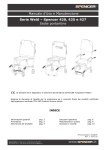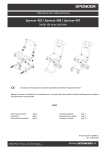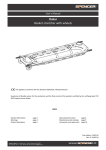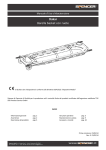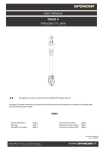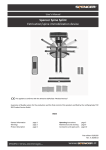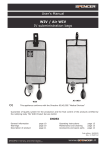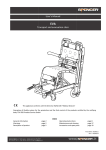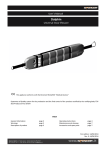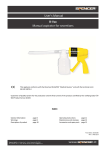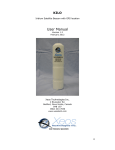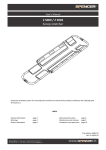Download User`s Manual Evacuation chairs
Transcript
User’s Manual SKIL-E, PRO SKIL-E, PRO SKIL-E MAX, SKIL-E READY, SKIL-OK, SKIL-OK MAX Evacuation chairs This appliance conforms with the Directive 93/42/CEE “Medical Devices” Guarantee of Quality system for the production and the final control of the products certified by the notifying body TÜV SÜD Product Service GmbH. INDEX General information Warnings Product description page 2 page 3 page 5 Operating instructions Maintenance and cleaning Accessories and spare parts page 7 page 11 page 12 First edition: 06/12/10 Rev. 3: 22/03/12 1 Thank you for choosing a Spencer product 1. GENERAL INFORMATION 1.1 Aim and contents The aim of this manual is to supply all the information necessary so that the client, will not only attain adequate use of the appliance, he will also be capable of using the instrument in the most autonomous and secure way possible. This includes information regarding technical aspects, functioning, maintenance, spare parts and safety. 1.2 Conservation of the instruction manual The instruction and maintenance manual must be kept together with the product, for the whole life of the device, inside the specially provided container and above all, away from any substances or liquids which could compromise perfect legibility. 1.3 Symbols used Symbol Meaning General or specific warning See instructions for use Lot number Product code The product is compliant with the specifications of the Directive 93/42/CEE Information for end users regarding the Directive 2006/66/CE regarding waste batteries This symbol refers to the accessory SK13026D Alarm for SKIL Series evacuation chairs 1.4 Servicing request For any information regarding the use, maintenance and installation, please contact the Spencer Customer Care Service on tel. 0039 0521 541111, fax 0039 0521 541222, e-mail [email protected] or write to Spencer Italia S.r.l. - Strada Cavi, 7 - 43044 Collecchio (Parma) - ITALY. In order to facilitate the assistance service, please always indicate or communicate the lot number (LOT) shown on the label applied on the box or on the device. 1.5 Demolition When the devices are no more suitable for being used, if they haven’t been contaminated by any particular agents, they can be disposed of as normal solid waste, otherwise follow the current regulations about demolition. This symbol refers to the accessory SK13013D Alarm for SKIL Series evacuation chairs DISPOSAL OF WASTE BATTERIES This symbol on the battery or on the packaging indicates that the battery provided with this product shall not be treated as household waste. By ensuring these batteries are disposed of correctly, you will help prevent potentially negative consequences for the environment and human health which could otherwise be caused by inappropriate waste handling of the battery. The recycling of the materials will help to conserve natural resources. At the end of their life hand the batteries over to the applicable collection points for the recycling of waste batteries. For more detailed information about recycling of this product or battery, please contact your local Civic Office, your household waste disposal service or the shop where you purchased the product. 2 1.6 Labelling Each device has got an identifying label, positioned on the device itself and/or on the box. This label includes information about the Manufacturer, the product, CE mark, lot number (LOT). It must never be removed or covered. 2. WARNINGS 2.1 General warnings • The product must be used by trained personnel only, having attended specific training for this device and not for similar products. • Training routines must be registered on a special register in which the names of those trained, of the trainers, date and place are indicated. This register which will certify the eligibility of the operators to use the Spencer device has to be kept for a period of 10 years after the disposal of the device itself. This register will be made available to the Competent Authorities and/or Manufacturer if requested. • Spencer Italia S.r.l. is always available for conducting training courses. • Before carrying out any kind of operation on the appliance (training, installation, use), the operator must carefully read the enclosed instructions, paying particular attention to the correct safety precautions and to the procedures to be followed for installation and for correct use. • If the instructions belong to another device and not the device received, inform the Manufacturer immediately and avoid use of the device. • In the case of any doubts as to the correct interpretation of the instructions, please contact Spencer Italia S.r.l. for any necessary clarifications. • Do not allow untrained personnel to help when using the device as they may cause injury to the patient or themselves. • Perform the required maintenance and to respect the life span of the device, as indicated by the Manufacturer in the User’s Manual. • Before each use of device the perfect operating state of the device must be checked as specified in the Instruction manual. If any damage or abnormalities which could in any way influence the correct functioning and the safety of the device, of the patient and or of the user are detected, the device must be immediately removed from service and the Manufacturer must be contacted. • If any failure or incorrect functioning of the device is detected, it must be immediately substituted with a similar item so that the rescue procedures are guaranteed without any interruption. • Use of the device in anyway other than described in this manual is forbidden. • Do not alter or modify in any way the appliance; any such interference could cause malfunctions and injury to the patient and/or rescuer. • The appliance must not in any way be tampered with (modification, adjustment, addition, replacement). In such cases all responsibility will be denied for any malfunctions or injuries caused by the appliance itself; moreover CE certification and product warranty will be considered void. • Those who modify or have modified, prepare or have prepared medical appliances in such a way that they no longer serve the purpose for which they were intended, or no longer supply the intended service, must satisfy the valid conditions for the introduction onto the market. • Handle with care. • Ensure that all the necessary precautions are taken in order to avoid the hazards that can arise as the result of contact with blood or body fluids. • Register and store with these instructions: lot number, place and date of purchase, first date of use, date of checks, name of users, any comments. • When the device is being used, the assistance of qualified staff must be guaranteed. • Never leave an unassisted patient. The presence of at least one operator is essential at all times when the medical device is in use. • Do not store the device underneath any heavy objects which could cause structural damage. • Store in a cool, dry, dark place and do not expose to direct sun. • Store and transport device in its original packaging. • The device not be exposed to or come into contact with any source of combustion or inflammable agents. • Position and adjust the device taking care not to cause any obstruction to rescuers and or any other rescue equipment. • Attention: laboratory testing, post production tests, instruction manuals cannot always consider every possible scenario for use. This means that in some cases the performance of the product could be notable different from results to date obtained. Instructions are continually being 3 updated and are under tight surveillance of fully qualified staffs with adequate technical formation. • With reference to the D. Lgs. 24th February 1997, n. 46 emended by D. Lgs. 25/01/2010, n. 37 – Acknowledgement of Directive 93/42/CEE and 2007/47/CE, we remind both public and private operators that they are obliged to report any accident that involves any medical device to the Ministry of Health and to the Manufacture as specified and within time given by the European regulations. In addition, both public and private operators are obliged to inform the Manufacturer of any measures that should be adopted to make the steps necessary to guarantee the safety and the health of the patients and the users o any medical device. 2.2 • • • • • • • • • • • • • • • • Specific warnings Establish a maintenance program and periodic testing, identifying an reference employee. The person to whom the ordinary maintenance of the device is entrusted must ensure the basic requirements foreseen by the Manufacturer in the user’s manual. Training routines must be registered on a special register in which the names of those trained, of the trainers, date and place are indicated. This register which will certify the eligibility of the operators to use the Spencer device has to be kept for a period of 10 years after the disposal of the device itself. This register will be made available to the Competent Authorities and/or Manufacturer if requested. If any failure or incorrect functioning of the device is detected, it must be immediately substituted with a similar item so that the rescue procedures are guaranteed without any interruption. Before each use of device the perfect operating state of the device must be checked as specified in the Instruction manual. If any damage or abnormalities which could in any way influence the correct functioning and the safety of the device, of the patient and or of the user are detected, the device must be immediately removed from service and the Manufacturer must be contacted. When the device is being used, the assistance of qualified staff must be guaranteed. Never leave an unassisted patient. The presence of at least one operator is essential at all times when the medical device is in use. The device not be exposed to or come into contact with any source of combustion or inflammable agents. Store in a cool, dry, dark place and do not expose to direct sun. Do not store the device underneath any heavy objects which could cause structural damage. Store and transport device in its original packaging. Position and adjust the device taking care not to cause any obstruction to rescuers and or any other rescue equipment. For blocking and transporting the patient, follow the procedures approved by the Emergency Medical Service. Always respect the maximum load capacity, indicated in this user's manual. Do not operate if the weight is not correctly distributed. Upstairs movement, without having to lift the device, is allowed only with the PRO SKIL-E model. When using the device for evacuation over stairways or simple transport, at least two operators with suitable physical conditions are needed. 2.3 Contraindications and side effects The use of this device, if used as described in this manual, does not present any contraindications or collateral effects. 2.4 Physical requirements of the operators The Spencer SKIL-E, PRO SKIL-E, PRO SKIL-E MAX, SKIL-E READY, SKIL-OK and SKIL-OK MAX evacuation and transport chairs are for professional use only. Operators using the device must possess the following minimum requirements: • physical capacity for using the device. • be able to grab the device firmly with both hands • have robust back, arms and legs for lifting, pushing and pulling the evacuation chair • have a good muscular coordination Every operator has to be trained in safe and efficient patient transport techniques. Loading techniques, in case of extremely heavy patients, uneven terrains or unusual situations, may require more than the usual two operators. 4 Before deciding the roles of the operators during the use of the device, their capabilities must be evaluated. 3. PRODUCT DESCRIPTION 3.1 Intended use The evacuation chairs Spencer SKIL-E, PRO SKIL-E, PRO SKIL-E MAX, SKIL-E READY, SKIL-OK and SKIL-OK MAX are devices for seated patient transport, in cases in which another cumbersome device can not guarantee adequate and safe transport. The use of passive belts that slide on the stairs ensure a high safety level requiring no effort which permits safe and reliable evacuation during emergency operations. Designed for quick movement over stairways (downstairs and upstairs), but useable for normal transport as well. Intervention of the patient on the device is not expected. 3.2 n° Main components Component Material PRO SKIL-E ● ● ● 1 Front footrest 2 Rear left handle group 3 Rear right handle group aluminium ● 4 Front telescopic left handle aluminium group ● 5 Front telescopic handle group right aluminium ● 6 Blocking system handles (n° 2) rear aluminium ● 7 Seat sheet PVC 8 Backrest sheet PVC 9 Extendible handle aluminium 10 Rear wheels Ø 200 mm (n° rubber coated 2) polyurethane 11 Front wheels Ø 100 mm polypropylene pivoting with brake (n° 2) 12 Slide with belt (n° 2) aluminium aluminium SKILE covered rubber 13 Rear wheels Ø 200 x 32 polypropylene mm (n° 2) 14 Front wheels Ø 150 x 32 rubber coated mm (n° 2) polyurethane ● ● ● ● ● ● ● ● ● ● ● ● PRO SKIL-E MAX PRO SKIL-E AIR SKIL-E READY SKIL-OK SKILOK MAX ● ● ● ● ● ● ● ● ● ● ● ● ● ● ● ● ● ● ● ● ● ● ● ● ● ● ● ● ● ● ● ● ● ● ● ● ● ● ● ● ● ● ● 5 ● Fig. A Fig. B 3.3 Models SK20009E SKIL-E Evacuation chair with silver frame and black sheet SK10003E PRO SKIL-E Evacuation/transport chair with yellow frame and black sheet SK10203E PRO SKIL-E Evacuation/transport chair with silver frame and black sheet SK20104E SKIL-E READY Evacuation chair with fixed backrest, yellow frame and black sheet SK20010E SKIL-OK Evacuation chair SK10004E PROSKIL-E AIR Evacuation chair with yellow frame and black sheet SK10204E PROSKIL-E MAX Evacuation chair with silver frame, with load capacity 250 kg SK20011E SKIL-OK MAX Evacuation chair with load capacity 250 kg 3.4 Technical data Characteristics Width (mm) Length (mm) Length with opened handles (mm) Height with opened backrest (mm) Height with closed backrest (mm) Thickness closed (mm) Weight (kg) Maximum load capacity (kg) SKIL-E PRO SKIL-E PRO SKIL-E MAX PRO SKIL-E AIR SKIL-E READY SKILOK SKILOK MAX 530 900 1600 1070 330 12,7 150 550 1110 1450 1600 1070 330 14,2 150 550 1110 1450 1600 1070 330 14,2 250 410 1110 1450 1600 1070 330 13,8 150 530 900 1600 330 13,5 150 520 900 1540 1040 175 10 150 520 900 1540 1040 175 10 250 6 3.5 Reference standards Reference MDD 93/42/CEE MDD 2007/47/CEE Legislative Decree 24/02/1997, n. 46 Legislative Decree 25/01/2010, n. 35 UNI EN ISO 14971 UNI CEI EN 980 UNI CEI EN 1041 CEI EN 62366 MEDDEV 2.4/1a-b NB-MED 2.5.1 /Rec 5 MEDDEV 2.7.1 MEDDEV 2.12/1 UNI EN 14155 Title of document European Directive about Medical Devices Modifications to 90/385/CEE Directive about active implants, Directive 93/42/CEE about medical devices and Directive 98/8/CE about the introduction of biocides onto the market Application of the 93/42/CEE Directive about Medical Devices Modifications and additions to the 20/02/97 Decree n. 46 Application of risks managing to medical devices Graphic symbols used for medical devices labelling Information supplied by the medical devices manufacturer Medical Devices - Application of the utilisation characteristics of engineering to medical devices Guideline for the classification of medical devices Technical Documentation Clinical Data Medical Devices vigilance system Clinical evaluation of the medical devices for human beings - Part 2: Clinical evaluation plans 3.6 Environmental conditions Functioning temperature: from -15 to +50 °C Storage temperature: from -20 to +60 °C Relative humidity: from 15 to 90% 4. OPERATING INSTRUCTIONS 4.1 Transport and storage Before transporting the appliance, make sure that it is correctly packaged ensuring also that there are no risks of shocks, bumps or falls during the transport itself. Keep the original packaging for use in case of any further transport and for storage. Damage to the appliance caused during transport and handling is not covered by the guarantee. Repairs or replacement of the damaged parts are the responsibility of the client. The device must be stored in a dry, cool area away from direct sunlight. It must not be placed in contact with any substances or chemical agents which could cause damage and reduce safety characteristics. During storage take care not to put heavy materials onto the device. In no way and under no circumstances should the device be considered as a work top. 4.2 Preparation On receipt of the product: • Remove the packaging and display the material so that all components are visible. • Check that all the components/pieces on the accompanying list are present. The appliance must be checked before every use so as to reveal any working abnormalities and/or damage caused by transport and/or storage. Therefore, before using the device, check: • General functionality of the device • Fixation of nuts and bolts • State of use of the wheels and braking system • State of use of the caterpillar belts and slide • State of use of restraints, seat and headrest • Functionality springs If the device respects these conditions, it may be considered ready for use. 7 4.3 Functioning 4.3.1 Opening the device 1. Put the device in vertical position (fig. C) and pull out the extendible rear handle until it is blocked automatically using the purpose made locking hooks (this operation is not necessary for the SKIL-E READY model). 2. Loosen the restraints, to free the "chair". 3. Grab with one hand the seat and the extendible handle with the other, push both parts away from each other, until the chair is completely opened. The evacuation chair is now ready to be placed safely on the floor 4. Unblock the brakes of the two front Ø 100 mm wheels. The device is now ready for use. Fig. D Fig. C 4.3.2 Closing the device If the device is not occupied by the patient: 1 - Using both breaks, block both front Ø 100 mm wheels turned in inside direction. 2 - Only PRO SKIL-E and PRO SKIL-E MAX models: Disengage the rear handles (if positioned as in fig. E - F) by inserting the hooks in the blocking system (fig. G). 3 - Take position at the rear side of the chair, push both levers in order to unblock the extending handle and push it downwards along the special nylon guides. 4 - Grab the "seat" and the backrest and push them towards one another until the closed position is reached. 8 5 - Attach the belt around the body which will block the seat in position. Fig. E Fig. F Fig. G 4.3.3 Patient transport on stairways - Downstairs 1 - Apply the procedure described in paragraph 4.3.1. 2 - Grab the main handle firmly with both hands and let the patient sit on the chair. Make sure during this operation that both front Ø 100 mm wheels touch the ground. 3 - Secure the patient to the device using the special safety belts for the head and the body. 4 - Move close to the stairs and position on the side with the handrail. The first operator always keeps his hands on the handle firmly and follows the downstairs movement of the device, maintaining continual speed control and grip for a safe downstairs movement. The second operator should not be in front of the device (in front of the patient), but on the side of the device and to a certain distance (a few steps down), he must drive down operations in an optimal manner and must be prepared to intervene if necessary, without ever compromising his safety. 5 - Maintain a constant pressure in downward direction. This will improve the stability of the device (fig. H). 6 - When the descent has terminated, position the wheels correctly on the surface in order to guarantee safe and easy horizontal maneuvering. Fig. H 9 4.3.4 Patient transport on stairways - Upstairs (PRO SKIL-E and PRO SKIL-E MAX MODELS ONLY) This operation is possible with the PRO SKIL-E model only. 1 - Apply the procedure described in paragraph 4.3.1. 2 - Secure the patient to the device using the special safety belts for the head and the body. 3 - The first operator behind the device, has to block the rear handles (fig. G), rotating the hook downwards and fixing it to the hinge between slide and frame (fig. E - F). 4 - The second operator, in front of the chair, has to grab the front telescopic handles at the front and move them by pushing the button. 5 - Using adequate lifting techniques, the operators must simultaneously lift the chair and start transport (fig. I). For this type of transport the presence of a third operator is recommended in order to guide the other two. Fig. I 4.4 Troubleshooting PROBLEM The device does not unblock from open or closed position during the opening or closing procedure CAUSE The functional geometry has been compromised or damaged Difficulties extracting and inserting the telescopic handles (PRO SKIL-E and PRO SKIL-E MAX models) Presence of foreign bodies in the slide or breakage in aluminium part The headrest extendible handle does not block in open position Breakage of springs of the blocking system Difficulties in controlling the device during downstairs transport Damage of the sliding belt system Structural damage Improper use or untrained personnel 10 REMEDY Try complete lubrication and check if the problem has been solved; if not, take immediately the device out of service and contact the Spencer customer care service Clean accurately; if this does not solve the problem, do not use the device for upstairs transport and contact the Spencer customer care service Take the device immediately out of service and contact the Spencer customer care service Take the device immediately out of service and contact the Spencer customer care service Take the device immediately out of service and contact the Spencer customer care service 5. MAINTENANCE AND CLEANING 5.1 Cleaning Failure to carry out cleaning operations may involve the risk of cross infection due to the presence of secretions and/or residuals. The operator must always wear adequate personal protection such as gloves and mask etc. during all checking and cleaning procedures. The metal parts exposed to external influences are treated superficially and/or painted in order to obtain better resistance. Clean the exposed parts with delicate soap and a sponge and dry with a soft cloth. In order to obtain a shiny finish of the frame parts, use shiny creams and waxes for vehicles. We suggest the use of the polishing detergent Spencer STX 99. Do not use high-pressure water. It may penetrate joints and eliminate lubricants, increasing the risk of corrosion of components. Rinse carefully with warm water to remove all traces of detergents. Failure to do so could compromise the product and its life span. The device must be left to dry completely before storage. To dry the product after washing, or if used in a humid atmosphere, do not use direct sources of heat or flame. 5.2 Maintenance Establish a maintenance program and periodic testing, identifying an reference employee. The person who carries out the maintenance of the appliance has to guarantee the basic requirements indicated by the Manufacturer in the following paragraphs. All maintenance activities, both precautionary and special, must be registered on documents including technical reports about operations. This register has to be kept for a period of at least 10 years after the disposal of the device itself. This register will be made available to the Competent Authorities and/or Manufacturer if requested. With reference to the D. Lgs. 24th February 1997, n. 46 emended by D. Lgs. 25/01/2010, n. 37 – Acknowledgement of Directive 93/42/CEE and 2007/47/CE, we remind both public and private operators that they are obliged to report any accident that involves any medical device to the Ministry of Health and to the Manufacture as specified and within time given by the European regulations. In addition, both public and private operators are obliged to inform the Manufacturer of any measures that should be adopted to make the steps necessary to guarantee the safety and the health of the patients and the users o any medical device. 5.2.1 Precautionary Maintenance The person who carries out the precautionary maintenance of the appliance (user in person, Manufacturer/supplier or a third party) has to guarantee the following basic requirements: • Technical knowledge of the appliance and of the periodic maintenance procedures as described in these instructions. • Specific qualifications and training in the maintenance operations of the appliance in question. • The use of components/replacement parts/accessories that are either original or approved by the supplier, in such a way that each operation causes no alteration or modification to the appliance. • Possession of the checklist of operations carried out on the appliance. • Guarantee complete adherence to the instructions of the Directive 93/42/CEE which includes also the obligation towards the Manufacturer to maintain post sales records and traceability of the appliance if requested. During all checking, maintenance and cleaning procedures, the operator must wear adequate personal protection such as gloves, mask, glasses etc. Check ups to be performed before every use: • Functionality of the device • Fixation of nuts and bolts • State of use (moving parts, wheels, restraints, seat, headrest, sliding system, belts) • Correct lubrication of moving parts 11 The inspection frequency is determined by factors such as legal requirements, the type of use, frequency of use, environmental conditions during use and storage. Please note that you must do the cleaning as described in paragraph 5.1 and verify functionality before and after each use. Spencer Italia S.r.l. declines any responsibility for the proper functioning or damages caused to the patient or user by the use of devices not subject to routine maintenance, warranty and will void the compliance to the Medical Device Directive 93/42/CEE. The person responsible for every day maintenance can only substitute the spare parts indicated on paragraph 6.2 "Spare Parts". All other substitutions or repairs can be carried out only by the manufacturer or by a centre authorised by the manufacturer. 5.2.1 Periodic maintenance The device must be serviced by the manufacturer or by an authorised centre every year. If the correct revision is not carried out, the CE branding will no longer be considered valid as it will no longer be compliant with the 93/42/CE Directive for Medical Devices and therefore there is the possibility that it is no longer compliant with the safety standards declared by the Manufacturer at time of purchase. Spencer Italia S.r.l. will take no responsibility the incorrect functioning or any damage caused by a device that has not undergone regular revision. For any operations that are not carried out directly by the Manufacturer but by an authorised centre, we have to underline that a report regarding all operations carried out must be requested. This will permit both Spencer Italia S.r.l. and the end user to keep a log book regarding the operations carried out on the device. 5.2.1 Special servicing Only the Manufacturer or centres with written authorisation are authorised to complete any special servicing operations. For any operations that are not carried out directly by the Manufacturer but by an authorised centre, we have to underline that a report regarding all operations carried out must be requested. This will permit both Spencer Italia S.r.l. and the end user to keep a log book regarding the operations carried out on the device. The device, if used as indicated in the following instruction manual, has an average life span of 5 years. The life span can be expanded only following a general revision of the product that must be carried out by the Manufacturer or by a centre authorised by the Manufacturer. Spencer Italia S.r.l. will accept no responsibility for the incorrect functioning and /or damage caused by the use of any device which has not been repaired, or certified on expiry date by the Manufacturer or by one of the Manufacturer's Authorised Service centres. 6 ACCESSORIES AND SPARE PARTS 6.1 Accessories SK14000B SK21005E SK13026D SK13018C 6.2 Wall bracket Transport bag (SKIL-E, PRO SKIL-E and PRO SKIL-E MAX) Alarm system for SKIL Series evacuation chairs Strap for ankles Spare parts SK11000B SK12000B ST00427A ST21400A ST30428B ST30429B ST30449A Backrest sheet Seat sheet Pair of black belts with Derlin buckle 100 mm Ø wheel with brake Lower wheel carrier in black nylon Higher wheel carrier in black nylon Black PVC handle 12 ATTACHMENT A – TRAINING REGISTER The product must be used by trained personnel only, having attended specific training for this device and not for similar products. Keep this document at least 10 years from the end of life of the device. Operator’s name Training date Basic training Advanced training 13 Training method (user’s manual, during service, former class, etc) Trainer ATTACHMENT B – MAINTENANCE REGISTER Keep this document at least 10 years from the end of life of the device. Perform the required maintenance and to respect the life span of the device, as indicated by the Manufacturer in the User’s Manual. Code and description of the device Purchase date Lot (LOT) Bought by KIND OF SERVICE SERVICE DATE (Maintenance/ check/ extension of life span) OPERATIONS MADE ON THE DEVICE RESULT PERSON IN CHARGE OF SERVICE (Operator/Auth orized centre/ Manufacturer) Warning The information contained in this document could be modified without any warning and is not to be intended as a commitment on behalf of Spencer Italia S.r.l. Spencer products are exported to many countries and the same identical regulations are not always valid. For this reason there could be differences between the description here described and the product actually delivered. Spencer continually strives to reach the perfection of all items sold. We therefore hope you will understand if we reserve the right, at any time, to modify the shape, equipment, lay-out or technical aspects that are herein described. © Copyright Spencer Italia S.r.l. All rights reserved. No part of this document can be photocopied, reproduced or translated into another language without the written approval of Spencer Italia S.r.l. 14















